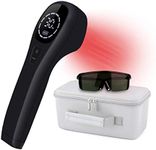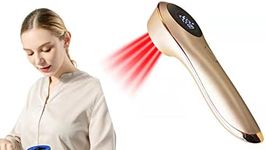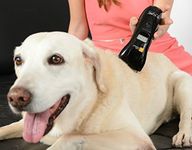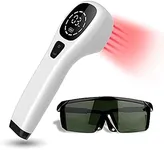Buying Guide for the Best Cold Laser For Dogs
Choosing a cold laser for dogs can be a great way to help manage pain, inflammation, and promote healing in your pet. Cold laser therapy, also known as low-level laser therapy (LLLT), is a non-invasive treatment that uses specific wavelengths of light to stimulate tissue repair and reduce discomfort. When selecting a device, it's important to understand the key specifications that affect how effective and safe the treatment will be for your dog. By learning about these features, you can make a more informed decision that matches your dog's needs and your comfort level with using the device.WavelengthWavelength refers to the length of the light waves emitted by the laser, usually measured in nanometers (nm). This is important because different wavelengths penetrate the skin to different depths and can target various tissues. For example, shorter wavelengths (around 600-700 nm) are absorbed more by the skin and are good for surface-level issues, while longer wavelengths (800-1000 nm) penetrate deeper and are better for muscles and joints. When choosing a device, consider what conditions you want to treat: for skin wounds or surface inflammation, a lower wavelength may be sufficient, but for joint pain or deeper tissue problems, a higher wavelength is more effective.
Power OutputPower output, measured in milliwatts (mW), determines how much energy the laser delivers to the tissue. This affects how quickly and deeply the treatment works. Lower power (under 500 mW) is generally safer and suitable for home use, especially for small dogs or sensitive areas, but treatments may take longer. Higher power (over 500 mW) can treat larger or deeper areas more quickly but requires more caution to avoid overexposure. If you are new to cold laser therapy or treating a small dog, starting with a lower power device is usually safer, while experienced users or those treating larger dogs may benefit from higher power.
Treatment Area SizeThe treatment area size refers to how much surface the laser can cover at once, often determined by the size of the laser head or applicator. A smaller treatment area allows for more precise targeting, which is useful for small wounds or specific joints, but it takes longer to treat larger areas. A larger treatment area is more efficient for treating big dogs or widespread issues but may be less precise. Think about your dog's size and the typical areas you need to treat: for small, targeted problems, a smaller head is fine, but for larger dogs or multiple areas, a bigger treatment area saves time.
Pulse vs. Continuous ModeSome cold lasers offer both pulsed and continuous modes. Continuous mode delivers a steady stream of light, which is good for general healing and pain relief. Pulsed mode sends light in bursts, which can help reduce heat buildup and may be more comfortable for sensitive dogs or longer sessions. If your dog is sensitive or you plan to use the device for extended periods, a pulsed mode can be beneficial. For quick treatments or less sensitive dogs, continuous mode is usually sufficient.
Safety FeaturesSafety features include things like automatic shut-off, timers, and protective eyewear. These are important to prevent accidental overuse or exposure, which can be harmful. Devices with built-in timers or automatic shut-off help ensure you don’t treat an area for too long. Protective eyewear is essential for both you and your pet to avoid accidental eye exposure. If you are new to using cold lasers or want extra peace of mind, look for devices with clear safety features.
Ease of UseEase of use covers how simple the device is to operate, including the controls, display, and instructions. A user-friendly device makes it easier to give consistent treatments and reduces the risk of mistakes. Look for clear instructions, intuitive controls, and helpful guides or support. If you are not very tech-savvy or want to ensure you can use the device confidently, prioritize models that are known for being easy to use.















